Effect of Sedimentary Facies Characteristics on Deep Shale Gas Desserts: A Case from the Longmaxi Formation, South Sichuan Basin, China
Abstract
1. Introduction
2. Geological Background
2.1. Regional Tectonic Characteristics
2.2. Sedimentary Facies Model
3. Materials and Methods
4. Result
4.1. Sedimentary Facies Characteristics
4.1.1. Sedimentary Model
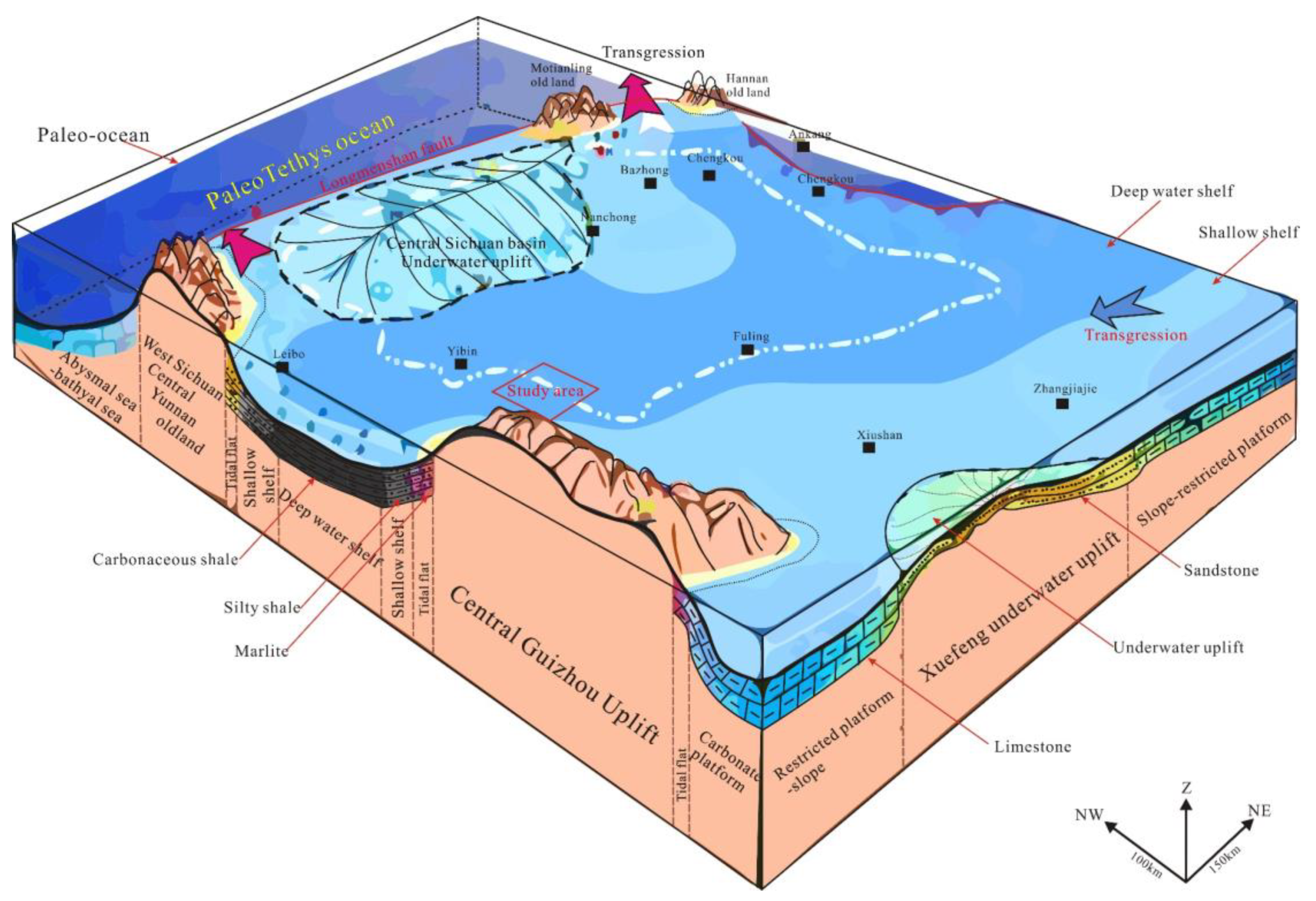
4.1.2. Types and Characteristics of Sedimentary Microfacies
4.2. Physical Properties and Pore Structure Characteristics
4.2.1. Physical Characteristics
4.2.2. Pore Structure
5. Discussion
5.1. Influence of Sedimentation on Reservoir Distribution
5.2. Influence of Sedimentary Microfacies on Mineral Composition of Reservoir
5.3. Influence of Sedimentary Microfacies on Pore Structure of High-Quality Reservoir
6. Conclusions
- (1)
- In the south of the Sichuan Basin, shore shelf sedimentary units developed successively from land to sea. In the early stage of the Longmaxi formation, it was located in the sedimentary facies zone of the offshore shelf with still water featuring an anoxic and reductive environment According to lithology, sedimentary structure, organic carbon content and mineral composition, six sedimentary microfacies can be divided, which are organic-rich siliceous mud shed microfacies, organic rich silty mud shed microfacies, deep water silty mud shed microfacies, shallow water silty mud shed microfacies, lime muddy silt shed microfacies and calcareous silty mud shed microfacies.
- (2)
- The shale porosity in the Changning area is mainly distributed in the range of 0.71–10.3%, with an average of 5%. The permeability ranges from 0.00016 × 10−3 μm2 to 9.9 × 10−3 μm2, with an average of 2.21 × 10−3 μm2. The organic matter content of the organic-rich siliceous shale and the organic rich silty shale is high, which provides the basis for organic pore development. The average porosity is more than 5%, and the permeability is more than 2 × 10−3 μm2; these two facies are the most favorable sedimentary facies for the formation of a high-quality shale gas reservoir.
- (3)
- Most of the silicalite in the shale is biogenetic and pores can be preserved between microcrystalline authigenic quartz grains, which provides storage space for organic matter migration. Organic matter is the material basis of shale gas formation, the higher the content of organic matter, the greater the hydrocarbon generation potential, and the higher the degree of pore development of organic matter. Silica and TOC content are positively correlated with porosity and specific surface area, while carbonate and clay mineral contents are negatively correlated with reservoir quality.
- (4)
- In the first member of the Longmaxi formation, the sedimentary water depth became shallower from bottom to top, and the sedimentary environment changed from a reduction to an oxidation environment. The contents of siliceous and organic matter decrease, while the contents of clay minerals and carbonate minerals show the opposite trend. The difference of sedimentary facies type essentially reflects different sedimentary provenance, which also determines the difference of mineral composition and the distribution of organic matter, and then controls the heterogeneity of the shale reservoir and the distribution of effective shale.
Author Contributions
Funding
Data Availability Statement
Acknowledgments
Conflicts of Interest
References
- Selley, R.C. UK shale gas: The story so far. Mar. Pet. Geol. 2012, 31, 100–109. [Google Scholar]
- Johnson, C.; Boersma, T. Energy security in Poland the case of shale gas. Energ Policy 2013, 53, 389–399. [Google Scholar]
- Gao, Z.; Fan, Y.; Xuan, Q.; Zheng, G. A review of shale pore structure evolution characteristics with increasing thermal maturities. Adv. Geo-Energy Res. 2020, 4, 247–259. [Google Scholar]
- Curtis, M.E.; Sondergeld, C.H.; Ambrose, R.J.; Rai, C.S. Microstructural investigation of gas shales in two and three dimensions using nanometer-scale resolution imaging. AAPG Bull. 2012, 96, 665–677. [Google Scholar]
- Javadpour, F. Nanopores and apparent permeability of gas flow in mudrocks (shales and siltstone). J. Can. Petrol. Technol. 2009, 48, 16–21. [Google Scholar]
- Hu, Q.; Ewing, R.P.; Rowe, H.D. Low nanopore connectivity limits gas production in Barnett formation. J. Geophys. Res. Solid Earth 2015, 120, 8073–8087. [Google Scholar] [CrossRef]
- Zhao, J.H.; Jin, Z.J.; Hu, Q.H.; Liu, K.Y.; Jin, Z.K.; Hu, Z.Q.; Nie, H.K.; Du, W.; Yan, C.N.; Wang, R.Y. Mineral composition and seal condition implicated in pore structure development of organic-rich longmaxi shales, Sichuan Basin, China. Mar. Pet. Geol. 2018, 98, 507–522. [Google Scholar]
- Klaver, J.; Hemes, S.; Houben, M.; Desbois, G.; Radi, Z.; Urai, J.L. The connectivity of pore space in mudstones: Insights from high-pressure Wood’s metal injection, BIB–SEM imaging, and mercury intrusion porosimetry. Geofluids 2015, 15, 577–591. [Google Scholar]
- Zhang, L.C.; Lu, S.F.; Jiang, S.; Xiao, D.S.; Chen, L.; Liu, Y.; Zhang, Y.; Li, B.; Gong, C. Effect of shale lithofacies on pore structure of the Wufeng-Longmaxi shale in southeast Chongqing, China. Energy Fuels 2018, 32, 6603–6618. [Google Scholar] [CrossRef]
- Li, H.; Tang, H.; Qin, Q.; Zhou, J.; Qin, Z.; Fan, C.; Su, P.; Wang, Q.; Zhong, C. Characteristics, formation periods and genetic mechanisms of tectonic fractures in the tight gas sandstones reservoir: A case study of Xujiahe Formation in YB area, Sichuan Basin, China. J. Pet. Sci. Eng. 2019, 178, 723–735. [Google Scholar] [CrossRef]
- Li, H.; Qin, Q.; Zhang, B.; Ge, X.; Hu, X.; Fan, C.; Tang, H. Tectonic Fracture Formation and Distribution in Ultradeep Marine Carbonate Gas Reservoirs: A Case Study of the Maokou Formation in the Jiulongshan Gas Field, Sichuan Basin, Southwest China. Energy Fuels 2020, 34, 14132–14146. [Google Scholar] [CrossRef]
- Li, H.; Wang, Q.; Qin, Q.; Ge, X. Characteristics of Natural Fractures in an Ultradeep Marine Carbonate Gas Reservoir and Their Impact on the Reservoir: A Case Study of the Maokou Formation of the JLS Structure in the Sichuan Basin, China. Energy Fuels 2021, 35, 13098–13108. [Google Scholar] [CrossRef]
- McGlade, C.; Speirs, J.; Sorrell, S. Unconventional gas-a review of regional and global resource estimates. Energy 2013, 55, 571–584. [Google Scholar]
- Zou, C.N.; Dong, D.Z.; Wang, Y.M.; Li, X.J.; Huang, J.L.; Wang, S.F. Shale gas in China: Characteristics, challenges and prospects (I). Pet. Explor. Dev. 2015, 42, 753–767. [Google Scholar]
- Chalmers, G.R.L.; Ross, D.J.K.; Bustin, R.M. Geological controls on matrix permeability of Devonian Gas Shales in the Horn River and Liard basins, northeastern British Columbia, Canada. Int. J. Coal Geol. 2012, 103, 120–131. [Google Scholar]
- Ross, D.J.K.; Bustin, R.M. The importance of shale composition and pore structure upon gas storage potential of shale gas reservoirs. Mar. Pet. Geol. 2009, 26, 916–927. [Google Scholar]
- Mastalerz, M.; He, L.; Melnichenko, Y.B.; Rupp, J.A. Porosity of Coal and Shale: Insights from Gas Adsorption and SANS/USANS Techniques. Energy Fuels 2012, 26, 5109–5120. [Google Scholar] [CrossRef]
- Zhang, J.Z.; Li, X.Q.; Wei, Q.; Sun, K.X.; Zhang, G.W.; Wang, F.Y. Characterization of Full-Sized Pore Structure and Fractal Characteristics of Marine–Continental Transitional Longtan Formation Shale of Sichuan Basin, South China. Energy Fuels 2017, 31, 10490–10504. [Google Scholar] [CrossRef]
- Slatt, R.M.; O’Brien, N.R. Pore types in the Barnett and Woodford gas shales: Contribution to understanding gas storage and migration pathways in fine-grained rocks. AAPG Bull. 2011, 95, 2017–2030. [Google Scholar]
- Yang, R.; He, S.; Yi, J.; Hu, Q. Nano-scale pore structure and fractal dimension of organic-rich WufengLongmaxi shale from Jiaoshiba area, Sichuan Basin: Investigations using FE-SEM, gas adsorption and helium pycnometry. Mar. Pet. Geol. 2016, 70, 27–45. [Google Scholar]
- Liu, W.; Liu, J.; Cai, M.; Luo, C.; Shi, X.; Zhang, J. Pore evolution characteristic of shale in the Longmaxi Formation, Sichuan Basin. Pet. Res. 2017, 2, 291–300. [Google Scholar] [CrossRef]
- Li, K.; Chen, G.; Li, W.; Wu, X.; Tan, J.; Qu, J. Characterization of marine-terrigenous transitional Taiyuan formation shale reservoirs in Hedong coal field, China. Adv. Geo-Energy Res. 2018, 2, 72–85. [Google Scholar]
- Peng, N.J.; He, S.; Hu, Q.H.; Zhang, B.Q.; He, X.P.; Zhai, G.Y.; He, C.C.; Yang, R. The effects of mineral composition, Organic nanopore structure and fractal characteristics of Wufeng and lower member of Longmaxi shales in southeastern Sichuan, China. Mar. Pet. Geol. 2019, 103, 456–472. [Google Scholar]
- Wang, C.; Zhang, B.; Lu, Y.; Shu, Z.; Lu, Y.; Bao, H. Lithofacies distribution characteristics and its controlling factors of shale in wufeng formation-member 1 of Longmaxi formation in the Jiaoshiba area. Pet. Res. 2018, 3, 306–319. [Google Scholar]
- Wang, R.; Hu, Z.; Sun, C.; Liu, Z.; Zhang, C.; Gao, B.; Tang, W. Comparative analysis of shale reservoir characteristics in the Wufeng-Longmaxi (O3w-S1l) and Niutitang (Є1n) Formations: A case study of the Wells JY1 and TX1 in southeastern Sichuan Basin and its periphery, SW China. Interpretation 2018, 6, SN31–SN45. [Google Scholar]
- Li, J.; Yu, T.; Liang, X.; Zhang, P.; Chen, C.; Zhang, J. Insights on the gas permeability change in porous shale. Adv. Geo-Energ. Res. 2017, 1, 69–73. [Google Scholar]
- Chalmers, G.R.L.; Bustin, R.M. The organic matter distribution and methane capacity of the Lower Cretaceous strata of Northeastern British Columbia, Canada—ScienceDirect. Int. J. Coal Geol. 2007, 70, 223–239. [Google Scholar]
- Liu, K.; Ostadhassan, M. The impact of pore size distribution data presentation format on pore structure interpretation of shales. Adv. Geo-Energy Res. 2019, 3, 187–197. [Google Scholar] [CrossRef]
- Bernard, S.; Horsfield, B.; Schulz, H.-M.; Wirth, R.; Schreiber, A.; Sherwood, N. Geochemical evolution of organic-rich shales with increasing maturity: A STXM and TEM study of the Posidonia Shale (Lower Toarcian, northern Germany). Mar. Petrol Geol. 2012, 31, 70–89. [Google Scholar]
- Milliken, K.L.; Rudnicki, M.; Awwiller, D.N.; Zhang, T. Organic matter-hosted pore system, Marcellus formation (Devonian), Pennsylvania. AAPG Bull. 2013, 97, 177–200. [Google Scholar]
- Pommer, M.; Milliken, K. Pore types and pore-size distributions across thermal maturity, Eagle Ford Formation, southern Texas. AAPG Bull. 2015, 99, 1713–1744. [Google Scholar] [CrossRef]
- Zargari, S.; Canter, K.L.; Prasad, M. Porosity evolution in oil-prone source rocks. Fuel 2015, 153, 110–117. [Google Scholar]
- Ko, L.T.; Loucks, R.G.; Zhang, T.; Ruppel, S.C.; Shao, D. Pore and pore network evolution of Upper Cretaceous Boquillas (Eagle Ford–equivalent) mudrocks: Results from gold tube pyrolysis experiments. AAPG Bull. 2016, 100, 1693–1722. [Google Scholar] [CrossRef]
- Wang, R.; Ding, W.; Zhang, Y.; Wang, Z.; Wang, X.; He, J.; Dai, P. Analysis of developmental characteristics and dominant factors of fractures in Lower Cambrian marine shale reservoirs: A case study of Niutitang formation in Cen’gong block, southern China. J. Pet. Sci. Eng. 2016, 138, 31–49. [Google Scholar]
- Wang, R.; Gu, Y.; Ding, W.; Gong, D.; Yin, S.; Wang, X.; Cui, Z. Characteristics and dominant controlling factors of organic-rich marine shales with high thermal maturity: A case study of the Lower Cambrian Niutitang Formation in the Cen’gong block, southern China. J. Nat. Gas Sci. Eng. 2016, 33, 81–96. [Google Scholar]
- Chen, S.; Zhu, Y.; Wang, H.; Liu, H.; Wei, W.; Fang, J. Shale gas reservoir characterisation: A typical case in the southern Sichuan Basin of China. Energy 2011, 36, 6609–6616. [Google Scholar]
- Cao, T.; Song, Z.; Wang, S.; Cao, X.; Li, Y.; Xia, J. Characterizing the pore structure in the Silurian andpermian shales of the Sichuan Basin, China. Mar. Petrol. Geol. 2015, 61, 140–150. [Google Scholar] [CrossRef]
- Tang, X.; Jiang, Z.; Li, Z.; Gao, Z.; Bai, Y.; Zhao, S.; Feng, J. The effect of the variation in material composition on the heterogeneous pore structure of high-maturity shale of the Silurian Longmaxi formation in the southeastern Sichuan Basin, China. J. Nat. Gas Sci. Eng. 2015, 23, 464–473. [Google Scholar]
- Tian, H.; Li, T.; Zhang, T.; Xiao, X. Characterization of methane adsorption on overmature Lower Silurian– Upper Ordovician shales in Sichuan Basin, southwest China: Experimental results and geological implications. Int. J. Coal Geol. 2016, 156, 36–49. [Google Scholar]
- Eberzin, A.G. The Middle and Upper Pliocene of the Black Sea Region. Stratigr. USSR. 1940, 12, 477–566. [Google Scholar]
- Chen, L.; Jiang, Z.; Liu, K.; Wang, P.; Ji, W.; Gao, F.; Li, P.; Hu, T.; Zhang, B.; Huang, H. Effect of lithofacies on gas storage capacity of marine and continental shales in the Sichuan Basin, China. J. Nat. Gas Sci. Eng. 2016, 36, 773–785. [Google Scholar]
- Chen, L.; Jiang, Z.; Liu, K.; Gao, F. Quantitative characterization of micropore structure for organic-rich Lower Silurian shale in the Upper Yangtze Platform, South China: Implications for shale gas adsorption capacity. Adv. Geo-Energy Res. 2017, 1, 112–123. [Google Scholar] [CrossRef]
- Han, C.; Jiang, Z.; Han, M.; Wu, M.; Lin, W. The lithofacies and reservoir characteristics of the Upper Ordovician and Lower Silurian black shale in the Southern Sichuan Basin and its periphery. Mar. Pet. Geol. 2016, 75, 181–191. [Google Scholar]
- Dong, T.; Harris, N.B.; Ayranci, K.; Yang, S. The impact of rock composition on geomechanical properties of a shale formation: Middle and upper Devonian Horn River Group shale, northeast british Columbia, Canada. AAPG Bull. 2017, 101, 177–204. [Google Scholar]
- Loucks, R.G.; Reed, R.M.; Ruppel, S.C.; Hammes, U. Spectrum of pore types and networks in mudrocks and a descriptive classification for matrix-related mudrock pores. AAPG Bull. 2012, 96, 1071–1098. [Google Scholar] [CrossRef]
- Chen, S.B.; Zhu, Y.M.; Qin, Y.; Wang, H.Y.; Liu, H.L.; Fang, J.H. Reservoir evaluation of the lower Silurian longmaxi Formation Shale gas in the southern Sichuan Basin of China. Mar. Petrol. Geol. 2014, 57, 619–630. [Google Scholar]
- Guo, Z.W.; Deng, K.L.; Han, Y.H. Sichuan Basin Formation and Development; Geological Press: Beijing, China, 1996; pp. 89–138. (In Chinese) [Google Scholar]
- Huang, H.; He, D.; Li, Y.; Li, J.; Zhang, L. Silurian tectonic-sedimentary setting and basin evolution in the Sichuan area, southwest China: Implications for palaeogeographic reconstructions. Mar. Petrol. Geol. 2018, 92, 403–423. [Google Scholar]
- Yang, S.C.; Hu, W.X.; Wang, X.L.; Jiang, B.Y.; Yao, S.P.; Sun, F.N.; Huang, Z.C.; Zhu, F. Duration, evolution, and implications of volcanic activity across the Ordovician-Silurian transition in the Lower Yangtze region, South China. Earth Planet. Sci. Lett. 2019, 518, 13–25. [Google Scholar]
- Wu, L.Y.; Lu, Y.C.; Jiang, S.; Liu, X.F.; He, G.S. Effects of volcanic activities in Ordovician Wufeng Silurian Longmaxi period on organic-rich shale in the Upper Yangtze area, South China. Pet. Explor. Dev. 2018, 45, 862–872. [Google Scholar] [CrossRef]
- Su, W.B.; Huff, W.D.; Ettensohn, F.R.; Liu, X.M.; Zhang, J.E.; Li, Z.M. K-bentonite, black-shale and flysch successions at the Ordovician-Silurian transition, South China: Possible sedimentary responses to the accretion of Cathaysia to the Yangtze Block and its implications for the evolution of Gondwana. Gondwana Res. 2009, 15, 111–130. [Google Scholar]
- Guo, X.J.; HE, S.L.; Chen, S. Research on micro structure of shale pores and distribution features based on nano-CT scanning and digital core analysis. Coal Geol. China 2016, 28, 28–34. [Google Scholar]
- Li, H.; Zhou, J.; Mou, X.; Guo, H.; Wang, X.; An, H.; Mo, Q.; Long, H.; Dang, C.; Wu, J.; et al. Pore structure and fractal characteristics of the marine shale of the Longmaxi Formation in the Changning Area, Southern Sichuan Basin, China. Front. Earth Sci. 2022, 10, 1018274. [Google Scholar] [CrossRef]
- Scherdel, C.; Reichenauer, G.; Wiener, M. Relationship between pore volumes and surface areas derived from the evaluation of N2-sorption data by DR-, BET- and t-plot. Microporous Mesoporous Mater. 2010, 132, 572–575. [Google Scholar] [CrossRef]
- Gregg, S.J.; Sing, K.S.W. Adsorption, Surface Area and Porosity, 2nd ed.; Academic Press: London, UK, 1982; Volume 2, pp. 1–50. [Google Scholar]
- Ji, W.; Song, Y.; Jiang, Z.; Wang, X.; Bai, Y.; Xing, J. Geological controls and estimation algorithms of lacustrine shale gas adsorption capacity: A case study of the Triassic strata in the southeastern Ordos Basin, China. Int. J. Coal Geol. 2014, 134–135, 61–73. [Google Scholar]
- Zhao, S.X.; Yang, Y.M.; Zhang, J.; Wang, L.S.; Wang, X.Z.; Luo, C.; Tian, C. Micro-layers division and fine reservoirs contrast of Lower Silurian Longmaxi Formation shale, Sichuan Basin, SW China. Nat. Gas. Geosci. 2016, 27, 470–487. [Google Scholar]
- Zou, C.; Dong, D.; Wang, S.; Li, J.; Li, X.; Wang, Y.; Li, D.; Cheng, K. Geological characteristics and resource potential of shale gas in China. Pet. Explor. Dev. 2010, 37, 641–653. [Google Scholar] [CrossRef]
- Cai, J.; Yu, B.; Zou, M.; Luo, L. Fractal characterization of spontaneous co-current imbibition in porous media. Energy Fuels 2010, 24, 1860–1867. [Google Scholar] [CrossRef]
- Cai, J.; Lin, D.; Singh, H.; Zhou, S.; Meng, Q.; Zhang, Q. A simple permeability model for shale gas and key insights on relative importance of various transport mechanisms. Fuel 2019, 252, 210–219. [Google Scholar] [CrossRef]
- Li, H. Research progress on evaluation methods and factors influencing shale brittleness: A review. Energy Rep. 2022, 8, 4344–4358. [Google Scholar] [CrossRef]
- Sun, Y.; Guo, S. Characterization of whole-aperture pore structure and its effect on methane adsorption capacity for transitional shales. Energy Fuels 2018, 32, 3176–3188. [Google Scholar]
- Cai, J.; Zhang, Z.; Wei, W.; Guo, D.; Li, S.; Zhao, P. The critical factors for permeability-formation factor relation in reservoir rocks: Pore-throat ratio, tortuosity and connectivity. Energy. 2019, 188, 116051. [Google Scholar]
- Zhang, J.; Li, X.; Zou, X.; Zhao, G.; Zhou, B.; Li, J. Characterization of full-sized pore structure of coal bearing shales and its effect on shale gas content. Energy Fuels. 2019, 33, 1969–1982. [Google Scholar]
- Bai, J.; Kang, Y.; Chen, M.; Chen, Z.; Tao, L.; Zhang, N.; Shi, W.; Zhu, Q. Dual effects of retained fracturing fluid on methane diffusion in shale containing adsorbed methane. Gas Sci. Eng. 2023, 110, 204872. [Google Scholar] [CrossRef]
- Guo, T.L.; Zeng, P. Geological Characteristics, Resource Potential, and Key Factors for Shale Gas in the Tectonically Complex Region; Science Press: Beijing, China, 2017; Chapter 3; pp. 230–231. [Google Scholar]
- Li, J.; Li, H.; Yang, C.; Wu, Y.; Gao, Z.; Jiang, S. Geological Characteristics and Controlling Factors of Deep Shale Gas Enrichment of the Wufeng-Longmaxi Formation in the Southern Sichuan Basin, China. Lithosphere 2022, 2022, 4737801. [Google Scholar] [CrossRef]


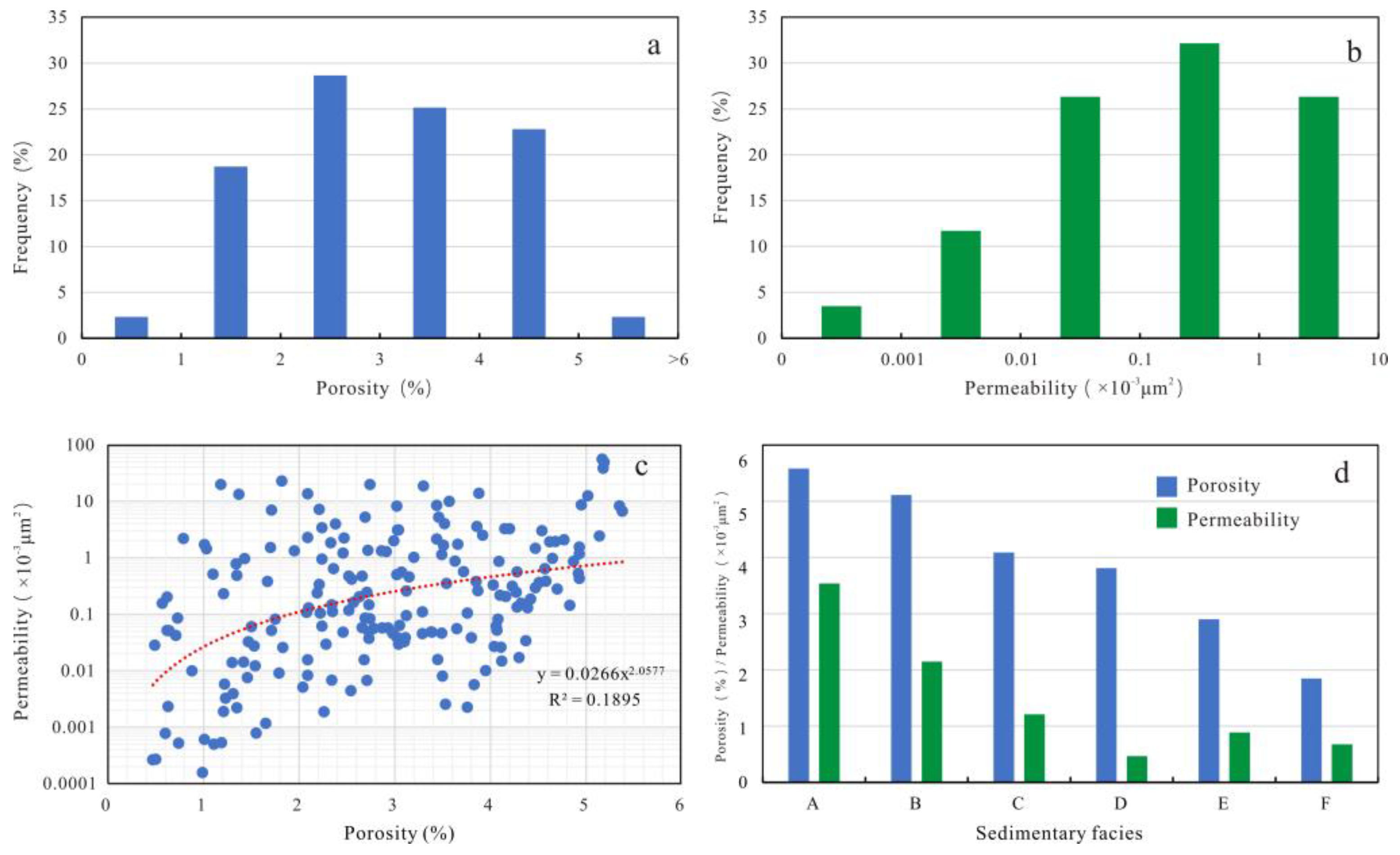

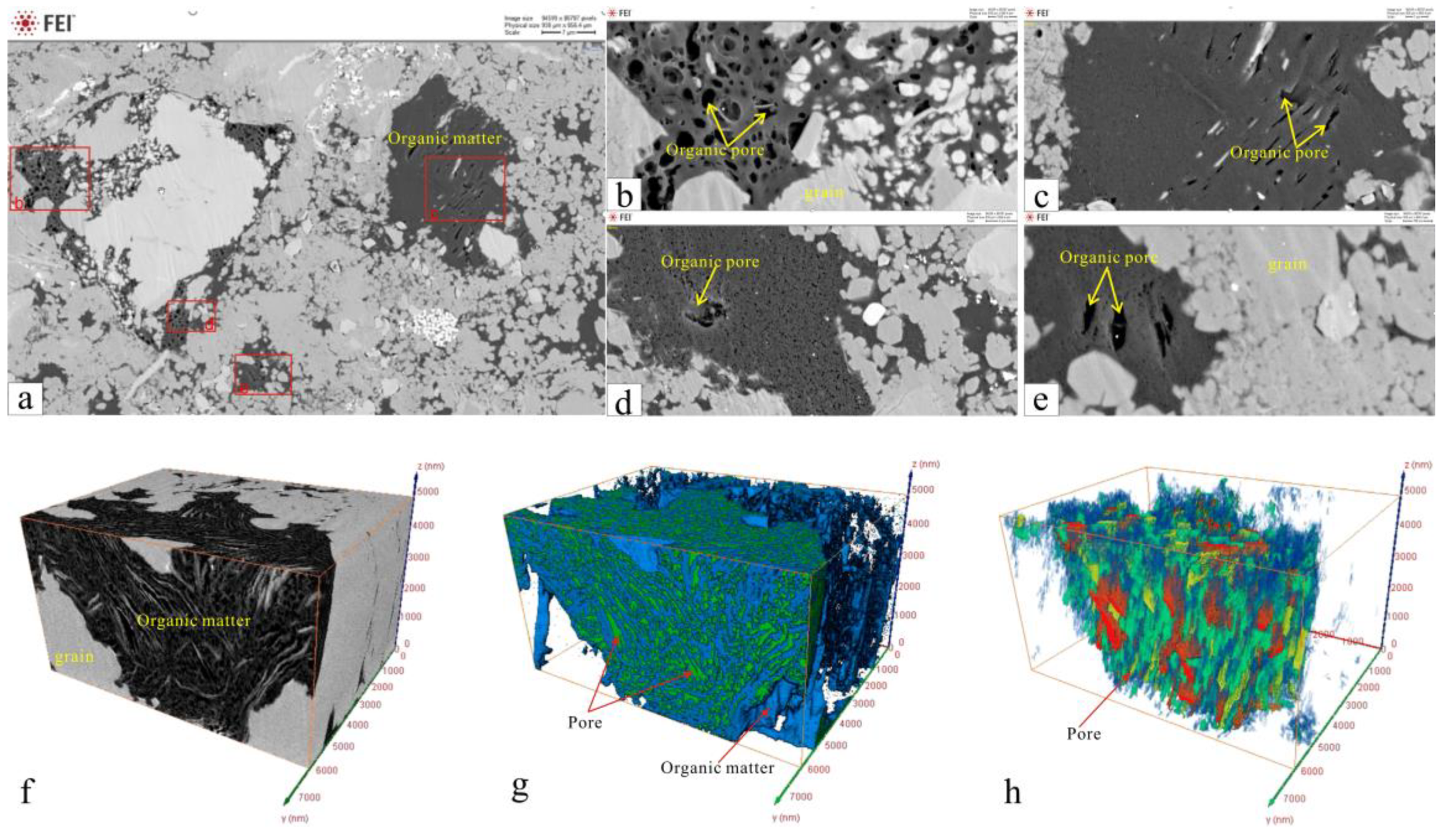


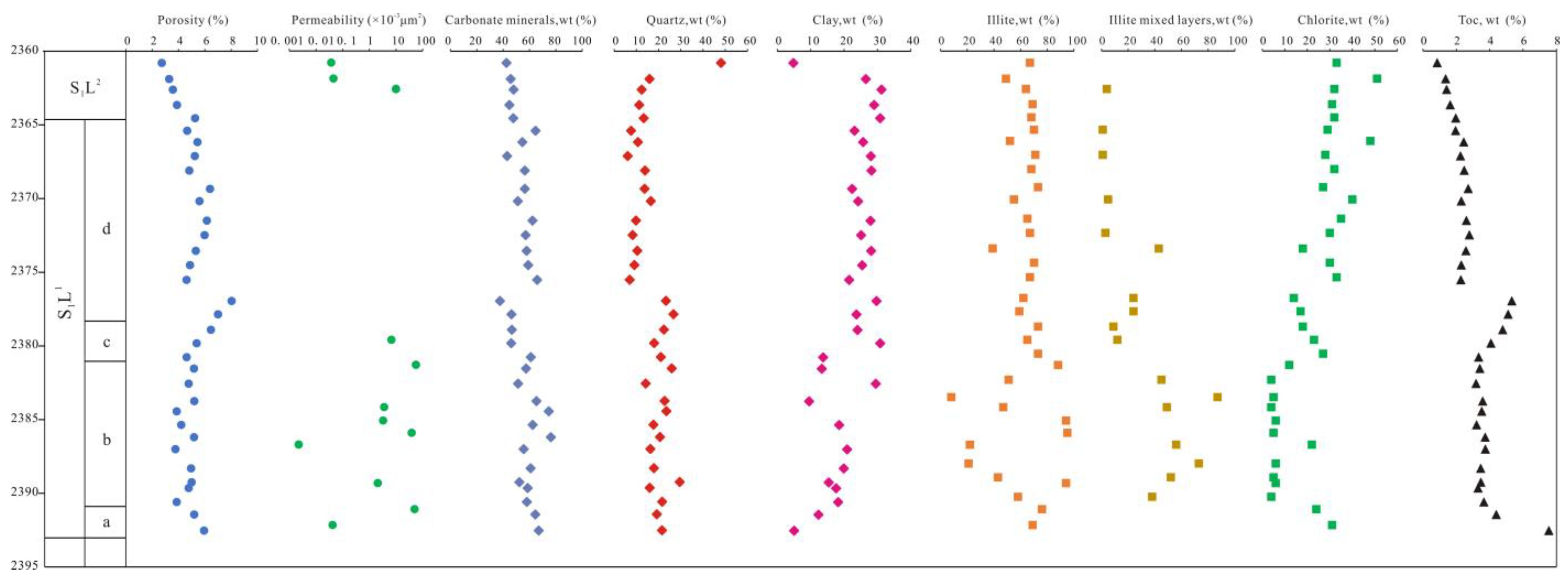



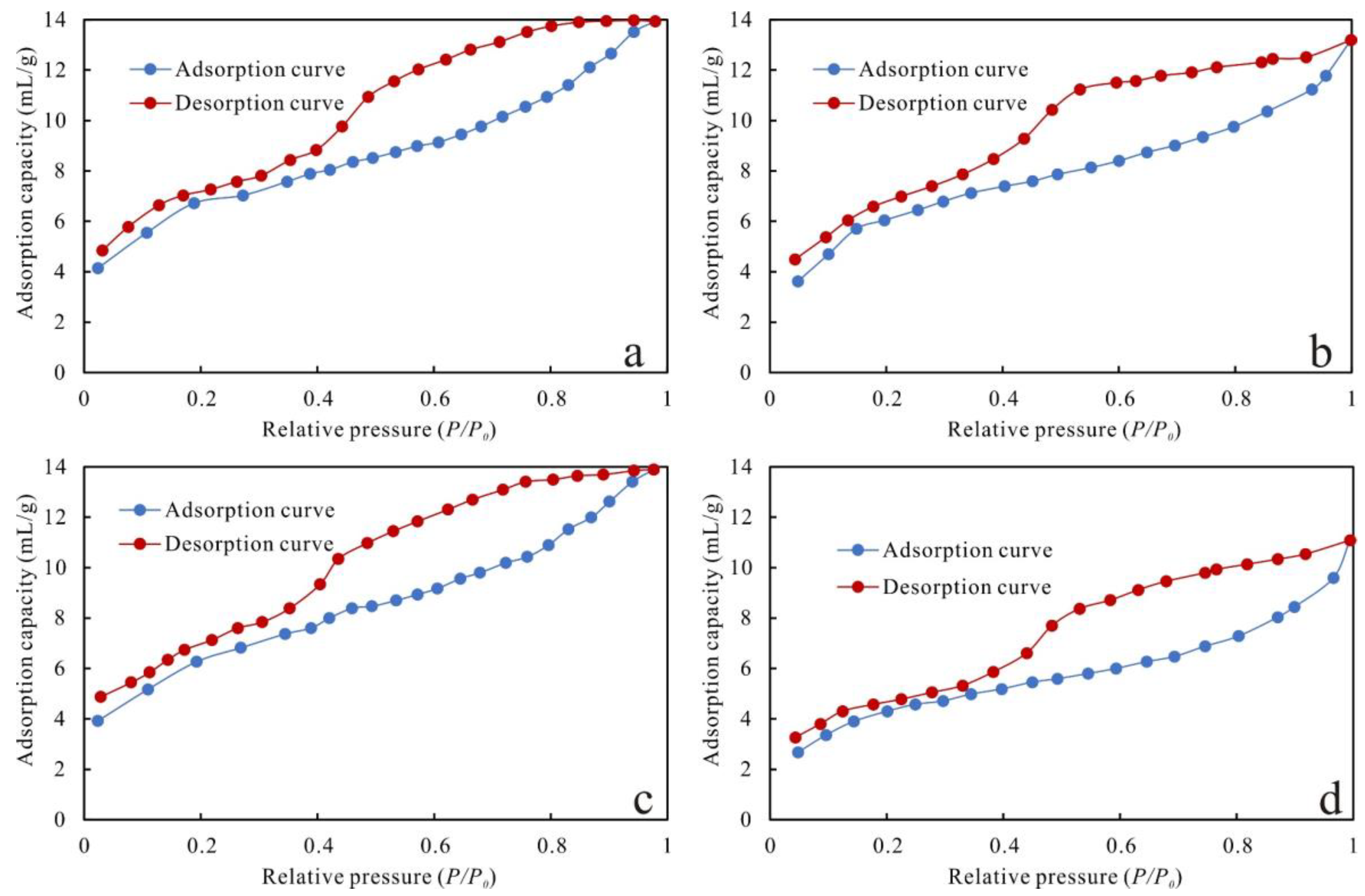
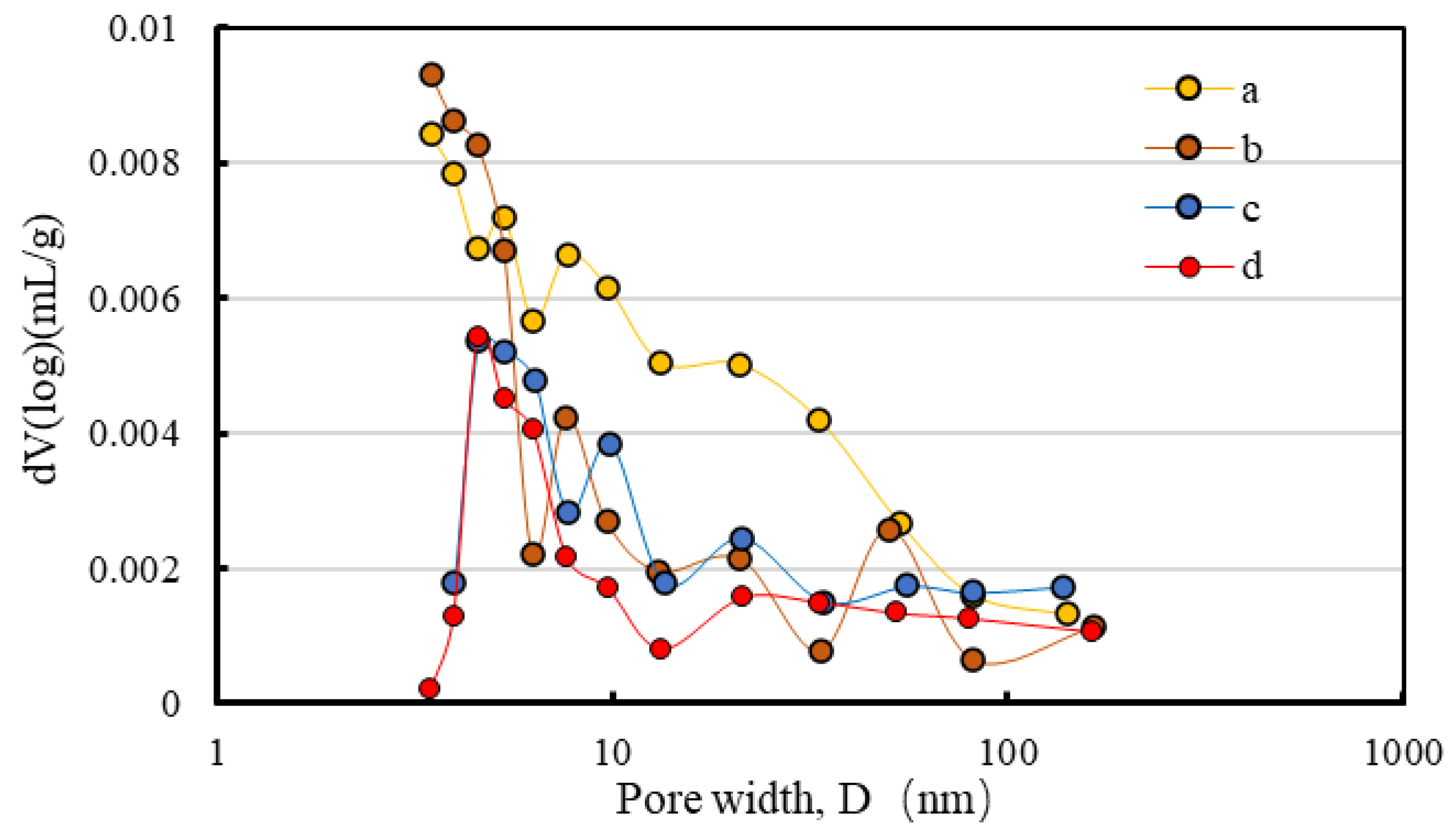

| Formation | Depth/m | Porosity (%) | Permeability (mD) | Mineral Contensts (%) | Clay Mineral Contensts (%) | TOC (%) | ||||||||
|---|---|---|---|---|---|---|---|---|---|---|---|---|---|---|
| Quartz | Feldspar | Calcite | Dolomite | Pyrite | Clay mineral | Llite | I/S | Chlorite | Mixed-Layer Ratio | |||||
| S1l1~1d | 2356.58 | 3.66 | 1.73 | 42.5 | 4.6 | 13.3 | 34.8 | 4.8 | 65 | 3 | 32 | 10 | 1.44 | |
| S1l1~1d | 2345.97 | 2.63 | 0.204 | 45.7 | 11.9 | 13.1 | 2.8 | 26.5 | 55 | 45 | 1.45 | |||
| S1l1~1d | 2307.75 | 4.93 | 1.54 | 47.9 | 8.5 | 10.1 | 2.3 | 31.2 | 71 | 29 | 1.47 | |||
| S1l1~1d | 2363.65 | 3.88 | 0 | 44.7 | 12.4 | 8.0 | 3.3 | 2.6 | 29.0 | 69 | 31 | 1.63 | ||
| S1l1~1d | 2365.40 | 4.66 | 0 | 47.7 | 7.5 | 9.1 | 4.2 | 0.7 | 30.8 | 70 | 1 | 29 | 10 | 1.95 |
| S1l1~1d | 2364.55 | 5.26 | 0 | 64.6 | 7.6 | 4.7 | 23.1 | 68 | 32 | 1.96 | ||||
| S1l1~1d | 2367.12 | 5.24 | 0 | 54.6 | 9.0 | 7.7 | 3.0 | 25.7 | 71 | 1 | 28 | 10 | 2.25 | |
| S1l1~1d | 2375.52 | 4.61 | 0 | 43.0 | 21.6 | 6.1 | 1.3 | 28.0 | 67 | 33 | 2.27 | |||
| S1l1~1d | 2374.52 | 4.87 | 0 | 56.5 | 6.4 | 7.5 | 1.4 | 28.2 | 70 | 30 | 2.29 | |||
| S1l1~1d | 2370.18 | 5.59 | 0 | 56.5 | 6.6 | 13.7 | 0.8 | 22.4 | 55 | 5 | 40 | 10 | 2.29 | |
| S1l1~1d | 2366.17 | 5.44 | 0 | 51.1 | 4.6 | 9.6 | 6.9 | 3.6 | 24.2 | 52 | 48 | 2.44 | ||
| S1l1~1d | 2368.10 | 4.82 | 0 | 62.3 | 9.8 | 27.9 | 68 | 32 | 2.47 | |||||
| S1l1~1d | 2373.55 | 5.31 | 0 | 57.1 | 5.3 | 8.3 | 4.2 | 25.1 | 39 | 43 | 18 | 10 | 2.57 | |
| S1l1~1c | 2371.50 | 6.15 | 0 | 57.8 | 10.4 | 3.7 | 28.1 | 65 | 35 | 2.60 | ||||
| S1l1~1c | 2369.34 | 6.39 | 0 | 59.0 | 4.8 | 9.1 | 1.7 | 25.4 | 73 | 27 | 2.71 | |||
| S1l1~1c | 2372.48 | 5.98 | 0 | 65.8 | 4.8 | 7.0 | 0.9 | 21.5 | 67 | 3 | 30 | 10 | 2.78 | |
| S1l1~1c | 2382.56 | 4.77 | 0 | 37.6 | 5.5 | 13.0 | 10.3 | 3.9 | 29.7 | 51 | 45 | 4 | 10 | 3.18 |
| S1l1~1b | 2385.36 | 4.20 | 3.26 | 46.3 | 18.0 | 8.7 | 3.3 | 23.7 | 94 | 6 | 3.21 | |||
| S1l1~1b | 2389.65 | 4.77 | 2.07 | 46.6 | 3.9 | 13.2 | 9.2 | 3.1 | 24.0 | 94 | 6 | 3.30 | ||
| S1l1~1b | 2380.77 | 4.62 | 0 | 46.1 | 10.3 | 7.7 | 5.1 | 30.8 | 73 | 27 | 3.34 | |||
| S1l1~1b | 2381.54 | 5.17 | 55.5 | 61.0 | 13.8 | 7.2 | 4.3 | 13.7 | 88 | 12 | 3.41 | |||
| S1l1~1b | 2388.31 | 4.95 | 0 | 57.4 | 12.3 | 13.6 | 3.4 | 13.3 | 21 | 73 | 6 | 10 | 3.46 | |
| S1l1~1b | 2389.25 | 5.00 | 0 | 51.3 | 2.5 | 7.8 | 6.4 | 2.5 | 29.5 | 43 | 52 | 5 | 10 | 3.47 |
| S1l1~1b | 2384.44 | 3.86 | 3.58 | 65.3 | 13.2 | 9.5 | 2.5 | 9.5 | 47 | 49 | 4 | 10 | 3.52 | |
| S1l1~1b | 2383.75 | 5.20 | 0 | 74.6 | 12.6 | 10.9 | 1.9 | 8 | 87 | 5 | 10 | 3.58 | ||
| S1l1~1b | 2390.59 | 3.86 | 0 | 62.4 | 9.8 | 7.9 | 1.4 | 18.5 | 58 | 38 | 4 | 10 | 3.65 | |
| S1l1~1b | 2386.20 | 5.18 | 38.3 | 76.2 | 13.6 | 7.0 | 3.2 | 95 | 5 | 3.73 | ||||
| S1l1~1b | 2387.01 | 3.76 | 0.00225 | 55.6 | 4.3 | 10.2 | 6.1 | 2.9 | 20.9 | 22 | 56 | 22 | 10 | 3.74 |
| S1l1~1b | 2379.82 | 5.38 | 6.68 | 60.9 | 10.6 | 7.3 | 1.3 | 19.9 | 65 | 12 | 23 | 10 | 4.07 | |
| S1l1~1b | 2391.44 | 5.19 | 49.1 | 52.3 | 19.5 | 10.0 | 2.8 | 15.4 | 76 | 24 | 4.39 | |||
| S1l1~1b | 2378.91 | 6.46 | 0 | 58.6 | 4.0 | 10.6 | 5.4 | 3.8 | 17.6 | 73 | 9 | 18 | 10 | 4.77 |
| S1l1~1a | 2377.86 | 7.00 | 0 | 58.0 | 15.8 | 5.8 | 2.2 | 18.2 | 59 | 24 | 17 | 10 | 5.10 | |
| S1l1~1a | 2376.95 | 8.03 | 0 | 64.4 | 13.5 | 5.7 | 4.1 | 12.3 | 62 | 24 | 14 | 10 | 5.33 | |
| S1l1~1a | 2392.53 | 5.94 | 0.0418 | 67.0 | 4.8 | 16.3 | 5.2 | 1.7 | 5.0 | 69 | 31 | 7.54 | ||
| Formation | Depth/m | Minerals Contents (%) | |||||||||||||
|---|---|---|---|---|---|---|---|---|---|---|---|---|---|---|---|
| Quartz | Albite | Orthoclase | Calcite | Dolomite | Ankerite | Illite | Chlorite | Apatite | Rutile | Pyrite | Sphalerite | Monazite | Else | ||
| S1l1~1a | 2521.2 | 56.14 | 5.07 | 1.06 | 5.72 | 6.56 | 15.85 | 0.65 | 0.05 | 0.1 | 0 | 0.97 | 0 | 0 | 7.81 |
| 2520.13 | 46.05 | 2.56 | 1.43 | 25.19 | 5.89 | 2.5 | 10.51 | 0.37 | 0.36 | 0.04 | 1.45 | 0 | 0.01 | 3.63 | |
| S1l1~1b | 2519.35 | 47.05 | 3.68 | 1.54 | 18.5 | 6.4 | 0.92 | 11.53 | 0.28 | 0.02 | 0.05 | 1.05 | 0 | 0.01 | 8.98 |
| 2513.75 | 49.26 | 4.5 | 0.85 | 12.3 | 14.79 | 2.54 | 9.69 | 0.43 | 0.06 | 0.04 | 1.02 | 0.01 | 0 | 4.5 | |
| S1l1~1c | 2511.52 | 37.25 | 3.3 | 0.91 | 12.24 | 10.12 | 4.17 | 17.3 | 0.67 | 0.06 | 0.04 | 2.19 | 0.04 | 0.01 | 11.7 |
| 2504.75 | 30.46 | 4.2 | 1.79 | 10.43 | 5.61 | 2.45 | 34.19 | 1.76 | 0.1 | 0.06 | 2.48 | 0 | 0 | 6.47 | |
| S1l1~1d | 2502.15 | 21.48 | 5.17 | 0.98 | 5.69 | 0.52 | 4.97 | 52.39 | 2.52 | 0.11 | 0.15 | 1.37 | 0 | 0.01 | 4.62 |
| 2496.88 | 21.81 | 5.6 | 1.31 | 4.5 | 0.95 | 0.34 | 54.98 | 3 | 0.05 | 0.17 | 1.5 | 0 | 0.01 | 5.78 | |
| Formation | Depth (m) | Pore Structure Parameters Based on Nano-CT Images | Pore Size Distribution of Nitrogen Adsorption | ||||||||
|---|---|---|---|---|---|---|---|---|---|---|---|
| Porosity (%) | TOC, wt (%) | OM, wt (%) | φipo (%) | Specific Surface Area (m2/g) | Specific Pore Volume (mL/g) | Average Aperture (nm) | Pore Volume (mL/g) | Micropore Proption (%) | Mesopore Proption (%) | ||
| S1l1~a | 2392.53 | 5.94 | 7.32 | 8.11 | 33.8 | 25.12 | 0.027 | 3.82 | 0.1026 | 11.55 | 88.45 |
| S1l1~b | 2385.36 | 4.2 | 2.93 | 5.32 | 7.6 | 16.75 | 0.011 | 3.5 | 0.0836 | 10.23 | 89.77 |
| S1l1~c | 2369.34 | 6.39 | 4.48 | 5.56 | 27.7 | 23.46 | 0.021 | 3.55 | 0.945 | 15.32 | 84.68 |
| S1l1~d | 2363.65 | 3.88 | 2.44 | 2.67 | 25.7 | 9.68 | 0.007 | 3.61 | 0.0651 | 8.56 | 91.44 |
Disclaimer/Publisher’s Note: The statements, opinions and data contained in all publications are solely those of the individual author(s) and contributor(s) and not of MDPI and/or the editor(s). MDPI and/or the editor(s) disclaim responsibility for any injury to people or property resulting from any ideas, methods, instructions or products referred to in the content. |
© 2023 by the authors. Licensee MDPI, Basel, Switzerland. This article is an open access article distributed under the terms and conditions of the Creative Commons Attribution (CC BY) license (https://creativecommons.org/licenses/by/4.0/).
Share and Cite
Wang, M.; He, J.; Liu, S.; Zeng, C.; Jia, S.; Nie, Z.; Wang, S.; Wang, W.; Zhang, C. Effect of Sedimentary Facies Characteristics on Deep Shale Gas Desserts: A Case from the Longmaxi Formation, South Sichuan Basin, China. Minerals 2023, 13, 476. https://doi.org/10.3390/min13040476
Wang M, He J, Liu S, Zeng C, Jia S, Nie Z, Wang S, Wang W, Zhang C. Effect of Sedimentary Facies Characteristics on Deep Shale Gas Desserts: A Case from the Longmaxi Formation, South Sichuan Basin, China. Minerals. 2023; 13(4):476. https://doi.org/10.3390/min13040476
Chicago/Turabian StyleWang, Meng, Jiang He, Shu Liu, Chunlin Zeng, Song Jia, Zhou Nie, Shengxiu Wang, Wei Wang, and Chun Zhang. 2023. "Effect of Sedimentary Facies Characteristics on Deep Shale Gas Desserts: A Case from the Longmaxi Formation, South Sichuan Basin, China" Minerals 13, no. 4: 476. https://doi.org/10.3390/min13040476
APA StyleWang, M., He, J., Liu, S., Zeng, C., Jia, S., Nie, Z., Wang, S., Wang, W., & Zhang, C. (2023). Effect of Sedimentary Facies Characteristics on Deep Shale Gas Desserts: A Case from the Longmaxi Formation, South Sichuan Basin, China. Minerals, 13(4), 476. https://doi.org/10.3390/min13040476





